
And with that, the glorious month of Manuary has come to an end once more. 30 days of beard, celebrated in the name of our lord Cockstrong, have came and gone like the whiskers of the mighty Siberian. I look back now at the things I've done in these 30 days of testosterone and at the things I've failed to do; my accomplishments as a man and my faults. I list them here:
My beard was not once trimmed, shaved, or styled in any manner. Neither was any of my "other hair" for that matter. Praise be the Men.
There was an abundance of flannel and plaid. Praise be the Men.
I organized a following. Praise be the Men.
Liquors were put away, and much beer was drank. Cheap bear, quality beer, no matter. Praise be the Men.
Sports... they were watched. Praise be the Men.
Sex was bountiful and exploratory. Praise be the Men.
And where have I failed my brethren?
Not once did I ice fish. Forgive me my brothers.
My time in garages speaking on engines was not what it could have been. Forgive me my brothers.
There was not an incident of fisticuffs. Forgive me my brothers.
I did not sit and view upon the wise Grizzly Adams or the mighty Macgyver. Forgive me my brothers.
Logs were not chopped, nor boulders heaved. Forgive me my brothers.
Labels: Beards, Flannel, Grizzly Adams, Lord Cockstrong, Manuary
I'm still working on bringing a lot of the information on this blog up to date, as it seems to be a much more daunting task than I originally thought. I've updated some of the links (with more to come), updated my Twitter, Bloglog, and Technorati accounts, and I've been fiddling with the best way to keep the blog up-to-date on Facebook. Whether or not I'm brave enough to embark on the journey of a full layout change is yet to be determined, but chances are I'm not.
The only thing I've actually yet to really jump on is posting some worthwhile, interesting content. I used to apologize when my posts were boring, but I think I've since grown comfortable with saying fuck that. My blog = my topics, and sometimes I just want to sit down and do something like write a list of all the junk I want to buy. Imagine how exciting and interestingly written that could be. Whoosh!
The only thing of actual substance that I do have to mention is that last night I was lucky enough to see The Wrestler, a film that I hope tears through the Oscars much the same as Mickey Rourke's career seems to be tearing through Hollywood these days. Plain and simple: The movie was incredible. Mickey Rourke is a hollow shell of a man in many cases, broken and alone, and yet some of the most emotional scenes in the movie are those in which he still lets personality shine through from Randy the Ram. Inviting kids to play NES with him or my favorite, the deli scene where Randy finds his groove in customer service are the real shining moments for this character, and make his tragic role that much more gut-wrenching. 
Professional wrestling fans are probably going to take home a lot from his performance and even I saw so much of the inner-workings of that world that I came off with much less bias against the sport than I previously had.
On a side note, a friend and I spoke recently about the ridiculous concept of critics seeing the Christ figure in EVERYTHING (I'll go into greater detail someday, for sure) but strangely enough as soon as I bash the Christ figure bandwagon The Wrestler drops a real-life goddamn Christ figure right in my lap. It's undeniable, it's visible, and hell, it's even mentioned. I'll be damned.
The bottom line: The Wrestler was incredible. I haven't seen Slumdog Millionaire or Milk yet (for shame), but it's my favorite for the Oscar for sure.
Labels: Blog, Darren Aranofsky, Film, Mickey Rourke, Movies, The Christ Figure, The Wrestler, Zenspace
Return of the Mack,
It is,
Return of the Mack,
Come on,
Return of the Mack,
Oh, my god,
You know that I'll be back
Here I am.
In all seriousness, it's the return of the Mack. The last post to grace this blog happened closer to a year ago than I'd like to admit. I let the blog slip in favor of schoolwork, social blah-blahs and did I mention, schoolwork? I've been missing the artful wordsmithery of the days of old lately, so I thought I'd offer myself a chance at blog resurrection, fake Jesus style. The first post back is almost always fluff, so I thought I'd at least get a few things out of the way and then on to the meaty bits next time (Hopefully soon?):
1. As I always, always do when returning to my blog after a break, I'll work out some layout changes in the next few weeks. I've been exploring the old links I had collected on here and some are defunct while others have turned into just plain bad sites. Either way, I'll give those a once-over too. If the blog looks scrappy in the near future, this is why.
2. For the first time ever this blog is linked to my Facebook account via RSS. I'm not 100% sure I like that idea. I hate RSS in the first place because I put mountainous amounts of effort into my layout (seriously, I can't code, this stuff takes me ages to do), and RSS nullifies pretty much all of that. It's just something to do I guess, but if it sticks, I'm sorry to everyone on Facebook that has to see note after note as my posts get more frequent.
3. Hopefully I'll start blogging with relative frequency and even writing outside the blog again, so my portfolio and other information will all be updated soon too. This is all starting to sound more like work than fun; what am I thinking?
Well, that's it for the virgin post. No pictures or anything. Just raw, dirty text. The way it should be for everyone's first time.
Labels: Blog, Random, Return of the Mack, Zenspace
Today I got beat up by a needle... over and over and over again. Take a close enough look and you can see that my forearms aren't the shape forearms are supposed to be. Also, the image is a little stretched, noticeable mostly in the digitization on my top arm making things look a little uneven.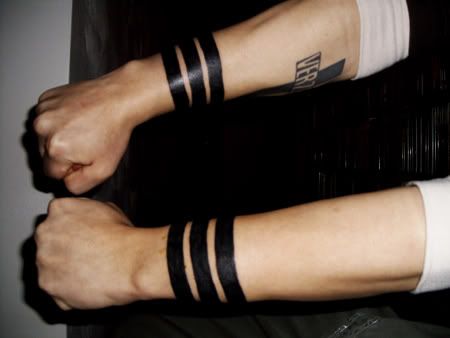
As a reward for taking the pain like a fucking warrior I'm eating cookies and drinking a large Mountain Dew. Mmmmm... Nothing says loving like stuff that's terrible for you. I'll add more pictures when things are less swollen and ridiculous looking. My next appointment is at the end of the month. My next-next appointment is sometime after that.
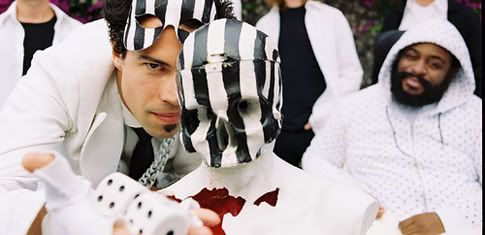
Nothing really needs said. Listen to more here.
Labels: ExitingARM, Hip-Hop, Music, Rock, Subtle, Unlikely Rock Shock
I thought I was safe. I thought that I had found the needle in the haystack. At least this time, anyways. I was totally wrong. This is why I need to learn to never, ever have faith in the manufacturers of video game consoles. They will all break. I imagine it's some corporate conspiracy involving repair fees or instigating early adopters to go back and re-buy the new SKU's that come out every couple months these days. Regardless, Microsoft being the greedy monster corporation they were, they probably went too far with the flood of "breaking damn near every other week" 360's out there. That's why they're fixing mine and everyone else's for free. At least when it comes to the Red Ring of Death. If your 360 is ailing from any other of the popular issues (broken DVD drive, scratching discs, freezing, transforming into a Decepticon and raping your pets whilst maiming close family members) then you're paying the damn repair bill if you're out of the 1 year warrany. Yeah, I didn't know that part until just now either. Fuck the fine print. Here's the hooker in all her glory:
I'll spare you all the horrific story of foreign customer service representatives and swear words and arguments, but I'll clearly state that it wasn't fun, or even what I'd call acceptable. Thanks to this little Snafu I won't be playing Rez HD, or Devil May Cry 4, or anything else scheduled within the next 3-4 weeks. This hurts deeply because I've gotta be honest, I was frothing at the mouth over Chessmaster Live. No joke at all.
Labels: 360, Broken Console, Red Ring of Death, Video Games, Xbox 360

I just wanted to post something ... anything, to get myself going again. Did I mention that I've always been this tough. I mean, god, look at me... that stare can shatter the will of fucking grizzlies!
Labels: Cody, Me, Picture Post, Random

I take it you've all heard that Esquire, some time last year, went ahead and deemed Scarlett Johannson the Sexiest Woman Alive. This made me feel pretty much vindicated, as I've been touting that same line for a couple years now. She IS the Sexiest Woman Alive, and sure enough, she just went ahead and proved it once again. See, Scarlett Johannson is making a CD, and while that's a terribly cliche thing for an actor/actress to do, I have to believe that this one is going to be a little different than Eddie Murhpy's 80s disaster, or 30 Odd Foot of Grunt if you even know who that is. The description I found, somewhere in my vast (about 10 minutes worth) internet search on this matter was pretty much perfect; "All movie stars have to at least try to make a CD, because no matter how famous a movie star is, a rock star is, by definition, cooler."
This all comes together, because Ms. Johannson is creating an album of Tom Waits covers, and also, because I've heard her sing. She's silly good. Go ahead, take a listen:
I'll reiterate; the Sexiest Woman Alive with the Sexiest Voice. Did I mention she's my wife? No? Oh yeah... that's not true. She *could* be my wife. We're the same age and all. Let's see what I can do about making that happen. As long as I'm posting pictures, another wouldn't hurt.
Labels: Esquire Magazine, MP3, Music, Scarlett Johannson, Sexiest Woman Alive, Tom Waits

Decoding Year Zero: The Dystopian Alternate Reality
Written: May 3, 2007
The dystopian concept, present commonly in literature, has proven to be a pervasive notion that imposes itself through various forms of media. Dystopian reality has been explored through theater, radio dramatization, and has even lent itself particularly well to film. Each form of media carries with it the hurdles that dystopian concepts must leap, and in doing so, certain media has proven to be a fertile ground for highlighting and focusing on dystopian ideals. Radio dramatization, in the case of H.G. Wells’ War of the Worlds, suggested that dystopia, otherwise limited to the restrictive and specific nature of literature, can by exceeding that medium become a tool of panic and fear. Film then progressed the notion of dystopia using the visualization of supposed dystopian societies that would have been previously relegated to imagination and nightmare. Now, with the advent of digital delivery and media in a communal, online setting, dystopia has once again adopted itself into new media. The alternate reality game (ARG), a narrative structure defined by user participation and concepts including the hive-like organization of internet communities, has become the latest medium to propose dystopia. The Year Zero album from musical artist Nine Inch Nails has initiated the use of ARG, in conjunction with popular music, as a tool for creating a dystopian narrative structure. Year Zero has taken the necessary steps to prove that new media, and in particular, the interactive nature of the ARG, will be an evolution in the role of dystopia, and how potent and contemporarily significant a vision they are able to provide.
In order to better explore the way in which Year Zero and ARG’s enhance the role of dystopia, one should first consider the definition of an alternate reality game. The platform came to rise with The Beast, a viral marketing experiment conducted surrounding the 2001 film A.I. The credits to A.I. included a listing for a “Sentient Machine Therapist” named Jeanine Salla. This position being impossible to perform with current technology, sleuthing viewers performed internet searches to discover that Jeanine Salla was a worker of Bangalore World University, in the year 2142 (Hon). The comprehensive university website led to a series of other websites and telephone numbers that all suggested the topics contained within were consistent and real. These events propelled the community to interact with fictional characters, and in doing so the creators of the game responded by suggesting puzzles and possible actions that the community could take to ascertain the entire narrative. The entire course of the game expired, and over one million participants had been involved with the solving, discovering, or following of the various puzzles. Popular media sources covered the events, and labeled The Beast as the first alternate reality game. Some of the most popular tenets that persist in ARG’s today were founded within The Beast, in particular, the common notion that most ARG’s focus upon, “This is not a game.” In short, ARG’s do everything possible to suggest through various means that the metacommunications announcing, “This is play,” not arise (McGonigal).
This tenet has been included in almost all ARG’s to date, and it is the most important propellant in the claim that ARG’s yield a more powerful and interactive narrative structure. The potency comes from the participant’s emotion that he is no longer simply viewing the story, but his actions are a significant part of the story. Video games have strived to achieve this sentiment for years, but have seemingly been trapped upon the notion of role-playing. Where a video game injects a player into a fictional world and the player is forced to assume a role, the ARG injects fiction into the actual world, and the player is left free to maintain his position, and in doing so, the presence of self and reality allows the ARG to provide a more powerful narrative structure.
Jordan Weisman, the creative director of 42 Entertainment, an ARG production company responsible for the Year Zero narrative among many others, suggested five other tenets that are beneficial in defining the role of the ARG (Weisman):
1. The concept of a hive mind. The generation we're speaking to now is so communications-obsessed and -enabled, we thought that if given a common emotionally charged history or mission, they would seek each other out and form into a cooperative to investigate and expose the story. We thought if we could get a couple hundred thousand people engaged in a project, various groups-with only one or two degrees of separation-would involve every skill base, every knowledge base on the planet. In reality, when that group formed (on the first ARG) and we had millions of participants instead of hundreds of thousands, not only did they represent every skill base and knowledge base, they didn't even need to go to degrees of separation-it was zero degrees of separation and they had every skill base. In retrospect, what we didn't realize was they had unlimited resources to devote to the subject-in terms of technology, canvassing, whatever was needed. It was very inspiring and daunting.
2. The experiment was to develop a narrative structure that was organic to the web. In looking at the web, I realized that it had been and still is used primarily for distribution of narrative formats that existed prior to the web-audio, video written word etc. There wasn't a narrative structure that embraced the chaotic and frustrating nature of the web. Stepping back and looking at it, I realized a lot of the daily experience of the web is looking through stuff we don't care about to find one thing we do care about. I likened it to archeologists who go through a lot of sand looking for a piece of pottery. After they find that shard they have an idea of how to find more, and if there are enough shards they can reconstruct the society that made the pottery. Similarly, in each of our campaigns we write very elaborate character-driven emotional stories, which is, in any entertainment format the key to everything. Then we create all the evidence that would have existed had that story taken place. Then we throw the story out and bury all the evidence in puzzles that are organic in the story. As the hive mind discovers those pieces and starts to crack the puzzle, they start to gather those bits of evidence. They start with a wide range of theories about what's going on and as they get more info they come to more consensus. Eventually, they've reconstructed our story, but now it's become their story because it's moved through the filter of these millions of minds-it's now a personal piece.
3. The 18-35 demographic has grown up in a marketing-saturated environment and has developed a sophisticated set of tools for avoiding the vast majority of marketing messages. As a rule of thumb, the bigger the neon sign the faster they'll run the other way. So the premise here was, instead of shouting, go the opposite way and whisper-hide it. Finding it becomes an act of discovery-something they can feel proud of and are willing to talk about with their friends. It shifts entertainment presentation from exhibitionist to voyeuristic.
4. The idea of hiding in plain sight. The premise here is that after building this groundswell of revealed info, we could then embed in subtle ways bits of info into the company's normal overt marketing campaign materials without disrupting the messaging they're doing in their normal campaigns. In doing so we turned those other media elements from "must be avoided" into "must be dissected." For a very small amount of additional media dollars, it turns your large investment into something people will seek out.
5. Surround the audience in what we call the electronic sphere in which they live. All demographics at this point live in sphere of communications tech that travels with them all day long-we didn't want these campaigns to live exclusively on their computer screen, we wanted to reach out through every communications mechanism to surround them and allow them to immerse themselves as much as 24 hours a day if they chose to. Whether that was reaching out to the campaign or having the campaign reach out to them, it meant that the campaign took place on the web, obviously, but also on cell phones fax machines, SMS messaging, voicemail, clues in newspaper personal ads, billboards, flyers at live events and at clubs around the world-every medium we could touch.
These tenets have been maintained effectively throughout the entire campaign for the dystopian ARG Year Zero. The course for Year Zero began when a fan noticed the highlighted letters on a Nine Inch Nails t-shirt spelled the phrase, “I am trying to believe.” The phrase led to the discovery of the first website, www.iamtryingtobelieve.com, in which the initial concepts of Year Zero were covered (Gunderson 01D). The website suggested through newspaper clippings that U.S. cities such as Los Angeles and Anaheim were victims of devastating biological attacks, and the government intended to use these attacks as an opportunity to introduce a pharmaceutical drug, Parepin, into the water supplies of major cities including New York, Washington D.C., Boston, and others. The creator of the website explains that Parepin may be responsible for, among many other things, muscle spasms, hallucinogenic reactions, inability to reach orgasm, dropping birth rates, and most importantly, the sedation of the user into compliancy, while the government suggests that Parepin is the immunization technique against various forms of bioterrorism (I Am Trying To Believe).

Subsequent pieces of the Year Zero narrative structure were discovered through USB drives left conspicuously at Nine Inch Nails performances. The community to which an ARG needs to solve the puzzles had already been built, and the contents of the flash drives were immediately subjugated to the tech-savvy puzzle solving of a hive-mind group. The songs contained within were placed under spectrographic analysis, and discovered to contain an image of another piece of the Year Zero narrative, The Presence, a massive hand stretching downward from the sky, as well as a telephone number that rang as the U.S. Bureau of Morality. These and other hidden pieces led to the discovery of the next Year Zero website, www.anotherversionofthetruth.com. The website contained a picture of a serene, rural setting of an idealized America, with the text, “A New Beginning! Zero Tolerance – Zero Fear – America is Born Again.” Dragging the mouse over the advertisement provided by the U.S. Bureau of Morality reveals a hidden image, one that would properly be described as an apocalyptic wasteland. The decaying remnants of an American setting are superimposed with the text, “The Beginning of the End. Zero Hope – Zero Chance.” Within this image, the first two words of, “This message brought to you by the U.S. Bureau of Morality” have been blacked out, to suggest that the destroyed society is in fact the result of this fictitious government agency (Another Version of the Truth).
Other websites and pieces of the puzzle were discovered using many similar tactics, and ultimately a timeline was built surrounding Year Zero and the major events that led to its eventual occurrence. The timeline, as created by users on www.ninwiki.com, reads as follows (Year Zero Timeline):
The NINWiki Year Zero Timeline
If nothing else, the large and growing scope of events contained within the timeline proves that the narrative structure within ARG’s is laden with depth, and the role of the participant in discovering these events is integral to providing a dystopia that is more in tune with a contemporary setting. Of particular importance is the event occurring on February 10, 2002, or in the adjusted timeline on February 10, 0000, this scientific experiment is the basis for which all of the underground banned information is said to have been sent back in time, and ultimately, the reason for which it is available to users presently. This tying of the story to our own possible future likens Year Zero to prophecy, in which the participants are able to discover future events, and approach their supposed occurrence with heightened regard for the narrative structure. This has always been possible with other mediums as well, but only with digital delivery has it been found to be a particularly potent driving force in appealing to the participant.
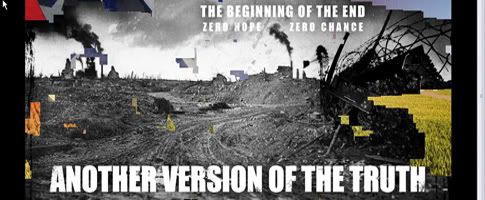
The summary of events known to presently occur in the Year Zero timeline shares not only the similarity of prophecy with other forms of media, but also many of the themes, motifs, and symbols within Year Zero are present in other supposed dystopian realities. Most obviously, the complacency induced society by the drug Parepin parallels not only the contemporary reliance of the populace on drugs like Prozac, but also the alcohol driven society in 1984, and very similarly the widespread use of Soma within Aldous Huxley’s Brave New World. This concept of dehumanizing the society is taken to its extreme in Year Zero however; as Parepin, through overly calming, is probably responsible for the removal of the sex drive altogether, and the subsequent lowering of the birth rate.
A lowered birth rate is also mirrored within the text The Handmaid’s Tale, as the result of widespread exposure to ecological disaster, whereas in Year Zero ecological disaster is replaced with bioterrorist attacks. Ultimately, both societies are left without many of their coastal cities. The Nation of Gilead in The Handmaid’s Tale shares many other concepts with Year Zero, specifically the removal of Constitutional Law and an elected President occurs in both texts, as well as that of a centralized religion. Each text also has a burgeoning resistance, as they are both early dystopian societies, unlike 1984 in which The Party is heavily established and resistance seems futile.
All of these shared concepts prove that dystopia within an ARG setting can deliver many of the same ideals as dystopia in popular literature, but it is through interactivity and communal participation that it attempts to surpass them. The nature of dystopia is to rely on contemporary society and then propose a potential future or alternate society that is a negative interpretation of modern fears. Literature and all media can succeed in this endeavor, but the internal narrative device contained in traditional media can only propose a possible, fictitious society. The reader is always left the opportunity to remove himself from the events, or suggest that his reality, his society, would be incapable of progressing on the path to a particular dystopia. ARG’s, on the other hand, suggest that the future society is the participant’s society, and they lay forth a consecutive series of events, almost always with relation to modern fears and anxieties, that seem probable and realistic. The participant is forced to accept the fear that his reality can lead to a dystopia, and he is presented with the course of events to maintain a vigilant watch for. Unfortunately, the strength and potency of the ARG dystopia only exists until the timeline has been proven false, and the events never occur. This too could be said of literature, as texts like 1984 lose some of their authenticity as the setting reveals itself to be inaccurate.
The most interesting aspect of the ARG is that in exciting the participant with a possible future reality, dystopian or not, the nature of belief, and volunteered belief, is raised as an issue. There may be similar events and modern fears, but most would still argue that a dystopian setting like Year Zero, set in the future, is largely and obviously fictional. Yet, the role of the player is skewed through their participation, and the player assumes a role of belief unknowingly, and defends the fictional world he has helped create. When gaps are present in the timeline, the hive-mind and community of players make the effort to fill and defend all arguments. In short, they help to create the setting just as much as they unravel it (McGonigal).
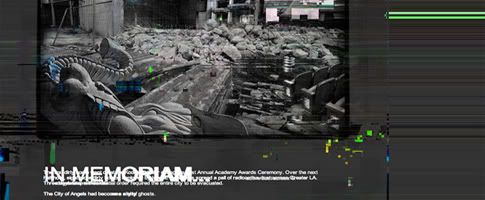
The Year Zero ARG benefits from this participatory creative notion held by its participants, but this particular piece of dystopian fiction also carries the weight of being an album of popular music. Just as many ARG’s rely specifically upon their role as viral marketing for films and games, the same must be said of Year Zero. The creation of a cohesive narrative structure between both the ARG and the Year Zero album makes use of trans-media storytelling, but each half of the structure is still in some way independent. In this situation, is Year Zero still valid as a piece of popular music? That is not to suggest that the Year Zero album doesn’t support the timeline, as it does. The lyrics and imagery all point towards the subsequent Year Zero event and specific items of the narrative structure are present. The songs each highlight and cryptically focus upon the plot devices within Year Zero. Starting with "Capital G," in which the leader of the supposed dystopian reality is blatantly intended to be President George Bush, other pieces of the puzzle, such as the military running the government in “Survivalism,” and the role of the church to watch the citizenry in "God Given,” are all nodded towards within the album (Sheffield). Take this particular instance from the song “The Warning,” concerning The Presence (Nine Inch Nails): “Some say it was a warning/Some say it was a sign/I was standing right there/When it came down from the sky/The way it spoke to us/We felt it from inside/Said it was up to us/Up to us to decide.”
Yet, while Year Zero the album may focus specifically on a dystopian world, it still must rely upon the foundation of popular music, which has become a largely disposable and forgettable machine. Is it safe to assume that without the addition of the ARG, that Year Zero would have failed in providing a narrative structure deep enough to propose a potential dystopia? The critical reception of the album has largely written off the potential concept of dystopia and instead suggested that the direction of the album served only as a catalyst to reinvigorate the quality of music Nine Inch Nails is able to deliver (Sheffield). This raises another question: While the ARG is open-ended and available in a communal setting, is it seemingly oppressive enough to alienate those that aren’t involved in the participation of the game? Ultimately, the critical reception of the album and the nature of popular music may be detracting to the Year Zero ARG, but the progress of the timeline and the participation of the players should continue nevertheless. The two elements of the larger project aren’t particularly independent, but one, the ARG in particular, should be able to carry the burden of the other if it fails in proposing a dystopian setting that will be popularly regarded.
It is the alternate reality game that is the most interesting aspect of the Year Zero narrative, and it is only fitting that while the album may stutter in its interpretation of dystopia, the strength of this particular piece of new media is enough to carry both into a cohesive and impressive position among many other dystopian settings. The ARG has proven through Year Zero to be a vivid and potent tool for dystopian narratives, and the definition and tenets of ARG’s are in line with propelling this plot further. That is not to suggest that Year Zero shatters the boundaries of all the dystopian literature and media that has come before it. Our fears are much the same as they have always been, and as such, dystopia must, in order to play upon them, recycle the concepts of 1984, The Handmaid’s Tale, and Brave New World. Where Year Zero propels from the traditional examples of dystopia is in providing the opportunity for the user to piece the narrative structure together, determine the connections with contemporary society, and ultimately, by creating a form of voluntary belief, possibly defend this fictional setting as a possible course for reality. Year Zero has given rise to a new evolution in dystopian setting, and it is one which grows through participation and is created with the possibility to change as quickly as our fears.
Works Cited
"Another Version of the Truth." Another Version of the Truth. 3 May 2007
Gundersen, Edna. Reznor nails big 'Zero' on the future." USA Today 19 Apr 2007: Life 01D.
Hon, Adrian. "The Rise of ARGs." Gamasutra. 09 May 2005.
CMP Game Group. 3 May 2007
"I Am Trying to Believe." I Am Trying To Believe. 3 May 2007
McGonigal, Jane. "A Real Little Game: The Performance of Belief in Pervasive Play."
Digital Games Research Association (DiGRA). Utrecht. Nov 2003.
Nine Inch Nails. “The Warning.” Year Zero. Nothing Records, 2007.
Sheffield, Rob. "Rolling Stone : Year Zero : Review." Rolling Stone. 17 Apr 2007.
Rolling Stone. 3 May 2007
Weisman, Jordan. "42's 5 principles of arg." CREATIVITY Volume 14. Issue 1. Jan 2006
03 May 2007
"Year Zero Timeline." ninwiki. 01 May 2007. MediaWiki. 3 May 2007
This research paper has been removed from its original format, and thus may contain certain formatting errors.
Marvel Ultimate Alliance wasn't easy to come by. I had to wait until just a few weeks ago to pick the game up; this is partly due to my strict law of judging certain games as being worth a certain amount of my dollars (in this case, no more than precisely $23.00), but also because for some reason people seem to have viewed it as popular enough for that price to not come to pass within something like a year of its release. I can't say I'm suprised as that's becoming basically the habit with games this generation, considering Dead Rising is still bringing in a regular $30 a solid year after its release, which is a game that I've decided I won't pay more than precisely $20.00 for. Don't ask me where I get these numbers from; they come to me like alien transmissions.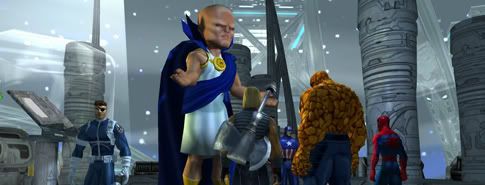
Regardless, I finally did get Marvel Ultimate Alliance, and I've since played through the games story, ultimately realizing why it is probably just that the price hasn't dropped. Marvel Ultimate Alliance is a pretty rich, and rewarding experience; it's also Diablo 2. Those two things are slightly related. Some quick, obvious examples of the similarities between both games:
- Both games are centered upon a 5 Act structure
- Both games play fundamentally the same (hack n' slash)
- Both games feature enemy mobs that carry the same benefit as their leader
- Both games are driven by story cutscenes outside gameplay (mostly anyways)
- Both games feature upgradeable skills
These are pretty generic things, but above and beyond all of them is the truth that the two games just feel undeniably similar. Remove from Diablo the Blizzard feel, and replace it with a Marvel feel, not to mention remove the Thundering Longsword of the Whale and replace it with Spider-Woman's Nano-Fiber Suit, and there isn't much else separating the two. Excluding of course the fact that Marvel Ultimate Alliance is buggy as all hell.
It wasn't buggy to the point of being distracting, but it was noticeable that the developer maybe reached a few steps beyond their ability in striving for a Diablo-like structure. This is most obvious when you come to realize that you're playing with 30 (or so) Marvel characters, and the game isn't set to recognize the character with whom you're controlling outside battle. Walking around the starting area (there's a separate one in each Act; Stark Tower, Dr. Strange's Mansion, Valhalla, the Moon home of the Inhumans, and Doomstark) and speaking with the NPCs can leave you groaning. In Asgard I'd speak to Valkyrie with Thor, and she would proceed to greet me as, "Human, welcome to Valhalla." I'm pretty sure that shit would offend the God of Thunder. Add to this the fact that with the additional downloadable characters players can literally speak to Bruce Banner as the Hulk, or speak to Dr. Doom, as... Dr. Doom. It's a little jarring, and it makes the game seem sloppy.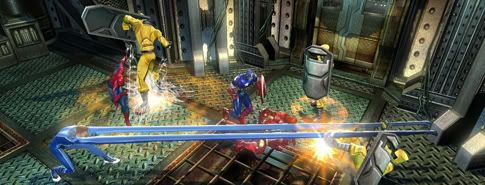
My team throughout the game consisted of Wolverine, Iron Man, Thor, and Deadpool pretty much exclusively. Originally, I planned to play through the game with my new Marvel favorite Moon Knight, but honestly, he sucked. Iron Man only maintained a position as temporary teammate until I'm able to unlock the Silver Surfer. There's no substitution for the Power Cosmic in the guise of man. Most of the characters have four costumes, which makes for a hell of a lot of customization in your team. Iron Man's Ultimates costume was a large factor in keeping him around; it's just plain awesome.
The game is very story driven, and the story is pretty much tantamount to anything you'd see coming from Marvel these days anyways. Expect all the super villains to gather, someone important to actually die (not Captain America!), and the world to get totally ravaged by the end of the game. Honestly, I never would have thought that the story would have been as good as it was. It takes you on a journey to Mephisto's Realm, Asgard, the homeworld of the Shi'Ar, the Skrull Planet, Latveria, and other places as well.
I can't say anything better or worse about it really; Marvel Ultimate Alliance was worth my dollars, and I'd dare say it would have been worth even more than $23.00. I've got a lot of unlocking and Achievement-whoring to do, and I'm looking forward to the majority of it. Diablo fans should love it...
Labels: comics, Diablo, Impressions, Marvel Comics, Marvel Ultimate Alliance, Reviews, Video Games, Xbox 360
Why does Fatal Fury: Battle Archives Volume 1, supposedly releasing next month, matter?
1. It will probably cost $20. I don't much care if it's a terrible, terrible game. It's a piece of gaming history, in a genre I find enjoyable, and $20 makes it totally worthwhile.
2. This is a 2D fighter, but sometimes Mai Shiranui will hit your ass so hard, that she'll knock you right into the next dimension.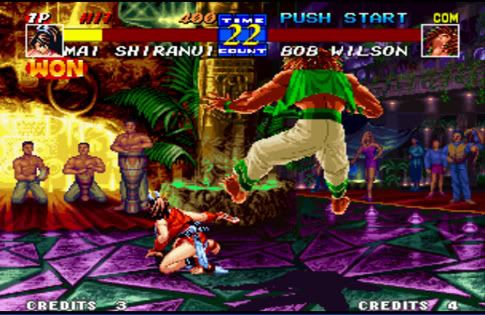
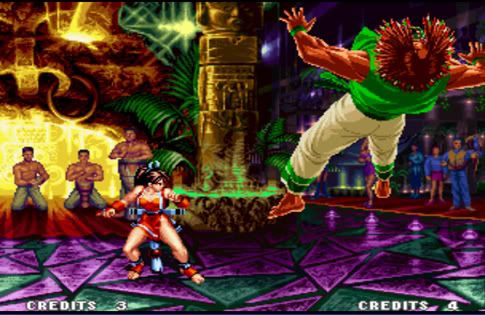
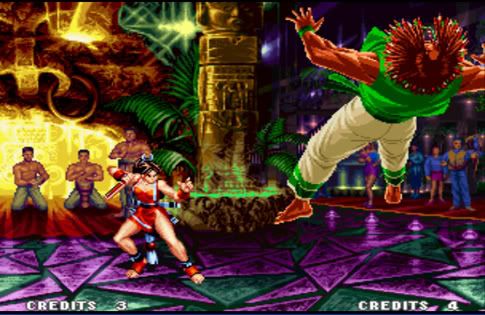
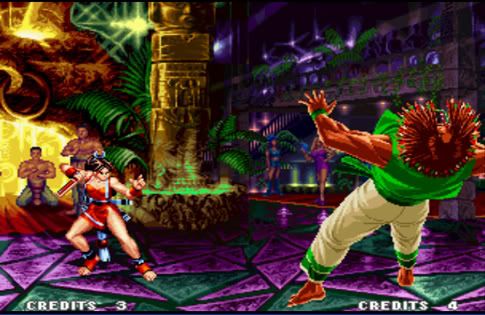
Now let's see if SNK can follow up with three more 2D fighters before the end of the year, and hopefully they'll all be at the same price-point too.
Labels: 2D Fighting, Fatal Fury, Mai Shiranui, Playstation 2, SNK
Let's take a look at the news dropping this week:
1. Peter Moore is leaving Microsoft to head up EA Sports. Not that it fucking matters, but I did like the guy. - Down 5 Points
2. Square Enix announces Final Fantasy 13 is 13% finished, and Final Fantasy 13 Versus is 1.3% finished. What?! - Down 10 Points
3. Microsoft announces that there will not be an X07 event. - Down 15 Points
4. A new Guilty Gear is announced. It's not a 2D fighter. - Down 20 Points
5. Capcom's mystery 2D fighter is not Street Fighter 4, but a Sengoku Basara game that will likely never be released in the US. - Down 25 Points
6. Capcom says Resident Evil 5 might not be released until 2009. - Down 30 Points
7. Bungie announces Halo 3 will likely ship WITHOUT online co-op. - Down 35 Points
8. The creator of Katamari Damacy, one of my favorite games, is making a game based on the whimsical nature of a double-headed dildo. + Up 35 Points
Tally Score = Breaking Even
That's a lot of bad, terrible, horrible, dirty, heart-crushing news; but that just goes to show that there are few things a double-headed dildo can't fix. Good looking out, Keita Takahashi!



